By all accounts, you’ve lived a full, fascinating, adventurous life, with first-hand knowledge of many cultures. How did you come to write and illustrate children’s books? Your passion for ancient languages, alphabets, and numbers has inspired and informed most of your picture books. I read somewhere that you speak more than a dozen languages. Please list some of these for us, and explain what first sparked your interest in linguistics. What’s your favorite language to speak or write? Congratulations on the publication in 2008 of two brilliant, exquisitely crafted books: Silent Music and Chee-lin: A Giraffe’s Journey. Silent Music, aside from being a very touching story about young Ali, coping with the bombings of Baghdad in 2003, is a beautiful tribute to the art of calligraphy. How did you learn Arabic calligraphy, and do you find it more difficult than Chinese calligraphy, because of its continuous form? You’ve said that with Chee-lin, where the text is divided into short chapters, you wanted to “bring out the words,” and that you were trying to create a new kind of genre. Though similar in format to Traveling Man, the narrative in Chee-lin is decidedly longer. Can you tell us more about your desire to experiment with picture chapter books? Could you briefly describe your overall creative process, once you’ve hit upon an idea? What role does the computer play in creating your pictures, and how do you think it has influenced you as an artist? Please describe your studio/workspace, and take us through a typical day.
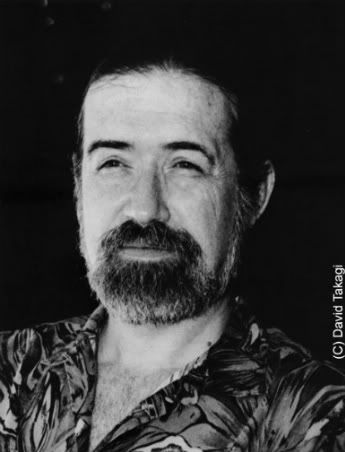
Today I have the distinct honor and privilege of welcoming award winning children's author/illustrator, James Rumford, to alphabet soup! As I mentioned in the profile I posted recently, Jim has published over a dozen picture books; most are works of historical fiction or biography, which display his passion for and unsurpassed knowledge of ancient languages, alphabets and numbers.
A native of Long Beach, California, Jim is a world traveler who has lived in Manoa, on the island of O'ahu, for the last thirty years or so. There he creates gorgeous picture books that are a distinctive blend of art, calligraphy, lyrical text, and innovative book design. Jim also makes beautiful handmade books for his own company, Manoa Press.
In 2008, Jim published Silent Music (Roaring Brook Press), and Chee-lin: A Giraffe's Journey (Houghton Mifflin Harcourt). I asked him about these two projects, his love for languages, and all about his general creative process. You will see, by his answers, why he has been called a Renaissance Man.
Aloha, e Jim. Komo Mai!
I want to start by saying that I love language as well as I love art, and I find the children's picture book the perfect medium to combine both loves. Picture books make it possible to explore the interactions between language and art. To put it simply: the fact that a picture is worth a thousand words is as true as the fact that a word is worth a thousand pictures.
This yin-yang, ever moving aspect has always intrigued me. When I was a boy, I had wanted to become an artist when I grew up. I would paint alongside my father, from whom I learned to draw and paint. As the years went by, I became more and more dissatisfied with painting pictures and hanging them on the wall. For me, there was more to drawing and painting than that. It wasn't until I was in my forties that I realized what I really enjoyed: drawing pictures and attaching words to them.
My wife, Carol, is always trying to get me to paint pictures for the walls in our house. I am not interested. People want me to paint them pictures as well. I am not interested. I tell them to go buy my books if they want one of my pictures. To sum up what I have said: a picture for me is not complete unless it is accompanied by words.
Words have always been important to me. Not just words in English, my native language, but words in any language. I have learned a dozen or so languages: French, German, Portuguese, Latin, Persian, Chinese, Kinyarwanda, Hawaiian, etc. I never tire adding to my linguistic repertoire. By this I don't just mean adding another language to the ones I already know. Rather, I mean that by learning another language, I enlarge my English horizons as well. I discover, by learning a foreign language, ways to express myself in English in new and different ways.
One example that comes to mind is "the fragrance of books." This is a Chinese expression to describe someone who is scholarly, learned. I once wrote this sentence about Famous Amos' cookie store and his promotion of literacy: His store has the smell of cookies and the fragrance of books. My editor made me change the sentence to the "fragrance of cookies" and the "smell of books." She was right "English-wise," but I was disappointed.
My love of language must be rooted in my genes -- somewhere deep inside. When I was eight, my mother couldn't get me to go to bed until I had copied all of the Chinese characters out of a children's classic, You Can Write Chinese, by Kurt Wiese. I found Chinese fascinating. Still do. In fact, not only do I love the sounds of a foreign language and the expressions that one can find in each, but I also love foreign languages that use different writing systems. I have learned Chinese and Persian, some ancient Egyptian, and Greek.
The stranger the writing system is to my eyes the more I am intrigued. One system, the Cherokee one, which I wrote about in Sequoyah, is a good example. It looks like Roman letters but it is not. What is more, the letters that do look like Roman ones don't have the same values. For example, the letter "A" is pronounced "go!"
I like writing systems because I love their beauty. Two of the most beautiful in the world? Chinese and Arabic. Chinese I learned by practice throughout the years. The apprenticeship is never ending. The practice is constant because the forms of the characters can become so expressive of mood and inner strength.
Picture book for ages 5 and up.
Arabic is different. It is a more rigorous system in that the shapes are already defined. The trick with Arabic calligraphy is the same as it is in English calligraphy: learning to reproduce time-honored shapes and to be able to write them flawlessly time after time.
I learned the Arabic alphabet from a Persian friend in high school. I went on to Berkeley, studying Persian, but it wasn't until I went to Afghanistan as a Peace Corps volunteer that I had formal training in Arabic/Persian calligraphy. I loved having an elderly gentleman scholar come to my house in the dead of winter and him teaching me the correct strokes.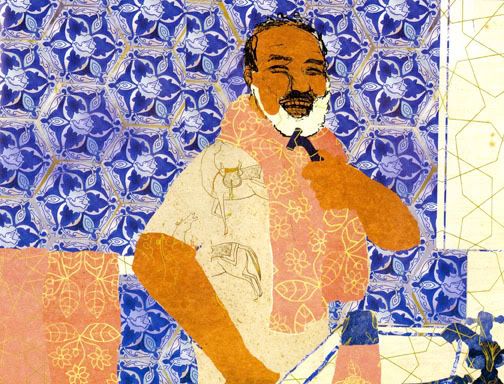
Illustration from Silent Music.
Writing another language, learning the calligraphy, is another way of widening my world view. The deeper I go exploring and the more I learn, the more I am able to express myself in new and different ways. This idea of widening one's horizons is the theme of my Calabash Cat -- a strange book, I might add. Strange? Yes, because every time I read it, I understand it in a new and different way.
Chee-lin began when I read Gavin Menzies' 1421: The Year China Discovered America. In that book, among the unsubstantiated things (to my mind) was the story about the giraffe. I thought that this story would make a good children's book, but as the book evolved I knew that it could not be a typical children's picture book. I decided to experiment with adding chapters to a picture book. I had tried this out to some extent with Traveling Man, but this time I wanted to go further than I had gone before. This is not a new idea. One of my favorite children's authors, Holling C. Holling, used this technique extensively.
Picture book for older readers, ages 10 and up.
One of the reasons was that I thought that the subject matter and my story were not for young picture book-age children. Rather, it was a book for older kids who might be into "chapter books." In retrospect, I wish that I had made the book smaller in format so that it looked more like a chapter book.
Picture books are usually eschewed by older kids. They think of them as "baby books." This is too bad, because a lot of picture books aren't for the audience the publishers intend them for.
For Chee-lin, I wanted to do paintings to illustrate the story. The paintings are a bit old-fashioned in that they illustrate only part of the long text on the facing page. I toyed around with the idea of tilting each picture (in an old-fashioned way), but found that would add confusion, not clarity.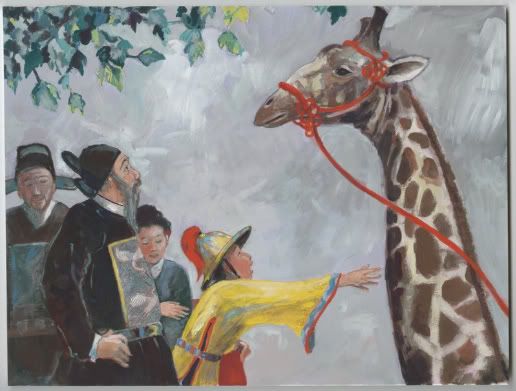
The illustrations for Chee-lin were rendered in casein, a type of milk-based paint.
Writing Chee-lin was fun because it was way longer than my other books. I had a number of characters to "develop" and I definitely wanted to set the scene in the different stages of Tweega's life. Of course, I didn't let the words do all of the work. I used the pictures and the designs surrounding the text to help transport the reader to far-away places and long-ago times.
I wrote most of Chee-lin in one sitting. The words just started flowing and I typed as fast as I could. Unfortunately, when I got to the end, the telephone rang and I stupidly answered it. When I returned to my computer, I couldn't remember the ending. The flow of words stopped. It took me a year to think of an ending, which only came after I read Bambi and saw how Felix Salten brought his story to an end.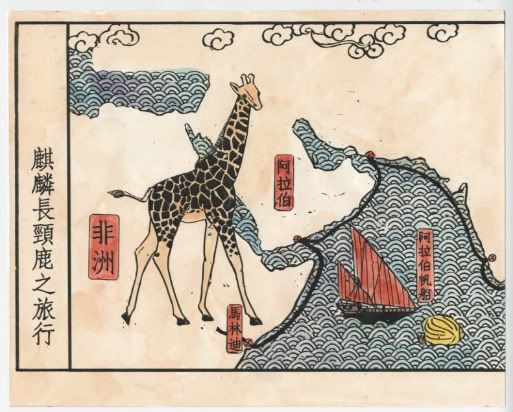
Part of the map charting Chee-lin's journey.
When I begin a book, I start with the words. They are that important to me. When I have the words just the way I want them, I begin drawing. This doesn't mean that I haven't been seeing pictures in my head, or I haven't been shaping the book (layout-wise) in my head. It means that when I am finished with the verbal aspect of the book, I begin with the visual aspect. Over the years, I have noticed something odd about this: once I have finished the words and have begun the pictures, I find it hard to switch back to working on the words. It's as though there's a toggle switch in my brain that shuts off the words once the art starts flowing.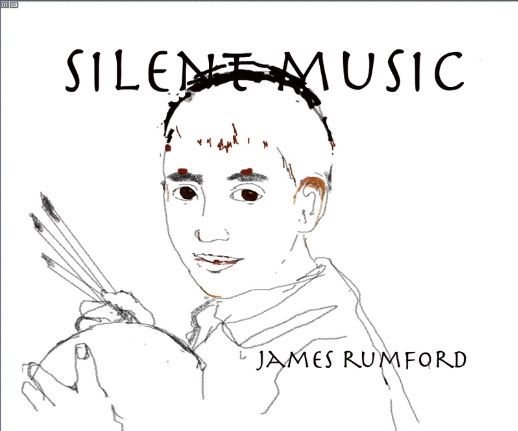
Early sketch of Silent Music cover.
I find that the art is the harder of the two "forces" to control. It might be that in drawing, there is more invested in any one picture than there is in any one story. By this, I mean that it is easy to change words, whole paragraphs. It is another matter to redo an entire picture. Worse, eliminate pictures that may have taken weeks to do.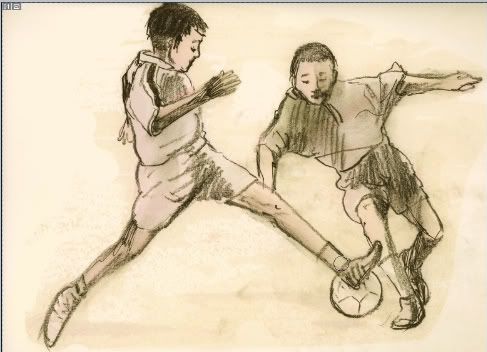
Soccer sketch from Silent Music.
Fortunately, today with the computer, it is becoming easier and easier to make changes on a picture. Now, I scan my sketches onto the computer, use Photoshop to correct them, print them out on art paper, and finish them up by hand. This relieves a lot of the stress of doing the art because if the picture doesn't turn out, it is just as easy to print out another and begin again.
Even easier is to do the art in the computer. This was the case with the art in Silent Music. That art began with sketches and I finished it up in the computer. For a book that is to appear this year, called, Tiger and Turtle, the art doesn't exist except in the computer; there are no sketches because I used the mouse to draw all the scenes.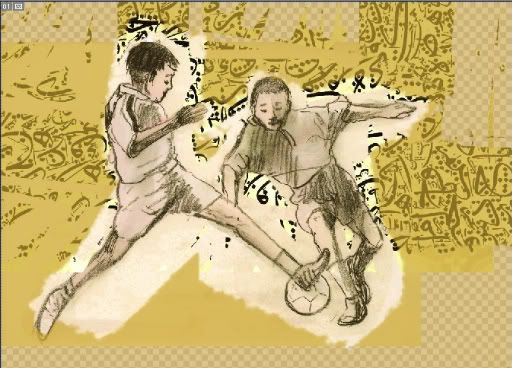
Early layout of soccer sketch with computer enhancement.
I love working with the computer because it allows me to experiment with color, form, shape, medium. It frees up my mind to come up with things that I don't think would be possible otherwise. This is equally true with writing the words and how they are laid out on the page.
Page design and book design are another aspect of children's books that I really enjoy. For me, a children's book is a movie, and designing the book is a way of creating a little theater with actors and scenes and dialog. For all of my books, I have had a major hand in designing the pages and the book as a whole. Silent Music is certainly an example of this, as the words, the illustrations and the layout of the book are so interconnected for me that it would have been impossible to give the text and the illustrations over to someone else to "assemble."
Final art of soccer illo.
When I write, I sit at my computer, which will soon be moved down to my renovated studio (it looks out on the yard and the hill, and above me, on the ceiling, I have put a Persian poem by Hafiz -- again, words and art working together). I get up early, at five, and begin.
Writing a children's book is not like writing a novel. Ninety percent is inspiration, the same kind of inspiration that is involved in writing a piece of poetry. Another 90% (I know that is illogical, but how else to describe the next step) is polishing the words. As soon as I have the words I want, I begin by placing them on pages. If the page breaks seem logical, if they add to the rhythm and the tension in the book, I move on to the next stage, sketching the illustrations.
When I do art I work at the kitchen table. This is to change as well. I will work in my studio, but I have a feeling that I will still sit at the kitchen table and draw. The kitchen is a nice place to work.
My personal favorite of all your books is Sequoya, which is dedicated to your father, Sydney, “who would stop the car to read every historic marker and who would certainly have told us this story.” What was your childhood like? What books, authors, or artists influenced you the most?
I didn't read a lot of books when I was a child. I don't read many today. I am, of course, talking about fictional work. I read tons of nonfiction. I am very careful what fiction I put into my brain. It has to be good. It has to be well written. I don't read for plot. I can think up a million plots. I read to enjoy the way the author expressed him/herself.
When I was little, one of my favorite books was Hoot Owl, by Mabel LaRue. It was about a white pilgrim boy who got lost in the woods and was brought up by Indians. He learned their language and their customs. I was fascinated with that. Perhaps that is why I have learned so many languages and lived so many places (Afghanistan, Chad, Rwanda, Saudi Arabia). The fascination I had with Hoot Owl is still with me.
My favorite children's picture book authors today tend to be the ones who write and illustrate. Peter Sis, Chris Van Allsberg, Allen Say, and Ed Young. They all write as well as they draw and all of them are a continual source of inspiration.
What are five highlights of your career thus far?
Two of them have to do with language. The first was when I translated one of my books (Seeker of Knowledge) into French and got it published, and the second was when I wrote a book in Brazilian Portuguese, which won several awards in Brazil.
The three other highlights would have to do with winning awards, I suppose. But when I think about it more, I think that they would have more to do with that special moment when someone comes up to me or writes and tells me how much my book has meant to him/her. This doesn't always happen, but when it does, I realize that I have been lucky enough to meet the one person for whom I wrote a particular book. This is an odd concept, I suppose. One writes to communicate with the masses. I take a different view. I write to communicate with one, just one of the eight billion out there.
Do you have a favorite childhood food-related memory?
When I was a kid, one of my favorite dishes that my mother made was a Hungarian chicken dish: Paprakosh (her pronunciation), that she learned from her sister, who had married a Hungarian. It was simple: a fryer cut up, smothered in celery and paprika, baked in the oven with water until the chicken came off the bones. This she served over noodles.
My memories of that dish bring back others as well -- about my mother and father and how supportive they were. My father was not a professional artist -- an insurance salesman, but he had studied art -- even went to the Chicago Art Institute until the Depression forced him to quit. (Here I will digress: one of the highlights of my career was to have my illustrations from Traveling Man on display at the Chicago Art Institute. My father would have been proud.)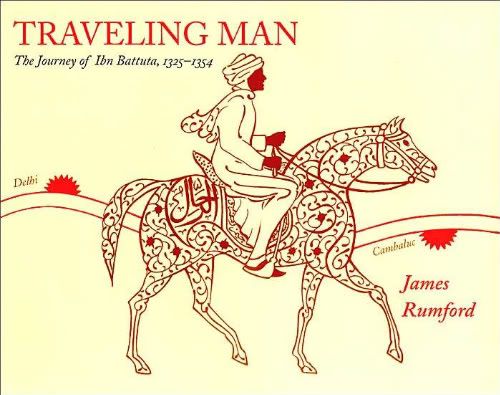
My father taught me a lot, not just about drawing and painting, but about learning. We were always looking things up in the Britannica encyclopedias that we had. From him I learned to love learning, and this concept I try to infuse in my books. Yes, my books are often an intellectual stretch, but that is how one learns -- by stretching and challenging one's mind. My mother was always there encouraging me. This type of encouragement can never be underestimated.
Which authors or artists, living or dead, would you most like to have dinner with?
I would love to have dinner with Su Dong-Po, Horace, Hafiz, John Singer Sargent and Winslow Homer.
Finally, what are you working on now?
I have a collaborative book: Max and the Dumb Flower Picture (Charlesbridge); a cautionary tale I made up about anger: Tiger and Turtle (Roaring Brook Press); a story about building a school in Chad, Africa: Rain School (Houghton Mifflin), and a story about Gutenberg and how he produced the first printed book: From the Good Mountain (Roaring Brook Press).
Thanks so much for visiting and chatting with us today, Jim. We look forward to all your new books!

In case you missed my profile of Jim, which includes reviews of The Island-below-the-Star and Dog-of-the-Sea-Waves, click here.
I also reviewed Silent Music here.
*Interior spreads from Silent Music posted by permission, copyright © 2008 James Rumford, published by Roaring Brook Press. All rights reserved.
*Interior spreads from Chee-lin posted by permission, copyright © 2008 James Rumford, published by Houghton Mifflin Harcourt. All rights reserved.
Viewing: Blog Posts Tagged with: hawaii month, Most Recent at Top [Help]
Results 1 - 16 of 16
Blog: jama rattigan's alphabet soup (Login to Add to MyJacketFlap)
JacketFlap tags: interviews, james rumford, hawaii month, Add a tag
Blog: jama rattigan's alphabet soup (Login to Add to MyJacketFlap)
JacketFlap tags: hawaii month, Add a tag
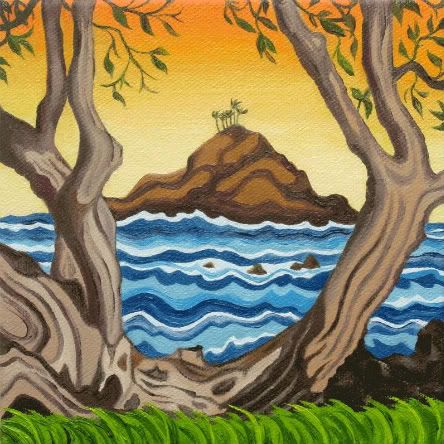
Hope you all had a nice Valentine's Day! Now, to announce the winner of our special art giveaway.
Yesterday, Hana-Maui artist Renee Coates tossed all the entries into her boyfriend's baseball cap, and the name she drew was ![]() lisa_schroeder !!
lisa_schroeder !!
Congratulations, Lisa! Renee will send your selected print, "Alau Island," very soon!
Thanks to everyone who entered the giveaway, and don't forget, every week there will be a new print offered on 52prints.com. Such a deal!
Happy Sunday :).
Blog: jama rattigan's alphabet soup (Login to Add to MyJacketFlap)
JacketFlap tags: hula, hawaii month, carla golembe, Add a tag

Tired of winter's bleak, gray landscape? Feeling a little cooped up and color starved?
You've come to the right place!
We're going to extend Hawai'i Month just a little longer here on alphabet soup. After all, it's still cold and snowy out, and we must keep up our mantra of warm warm warm. A great way to do just that is to dance the hula -- gently bend your knees, step right and left, then let your arms and hands tell a story. Once you've got the hang of it, roll your hips!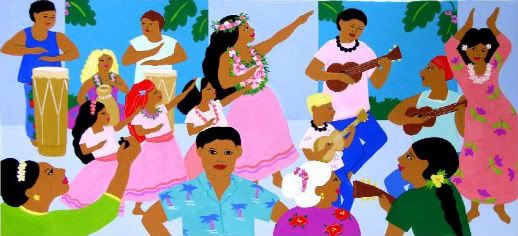
The best way to acquaint young readers with the history, meaning, and spirit of hula is with Carla Golembe's,The Story of Hula (Bess Press, 2004). Carla, herself a student of hula, and lover of all things warm, tropical, and soul-nourishing, expresses her love of this Polynesian art form in this charming, informative, interactive, gorgeous picture book/CD treasure.
Open the book, and listen to a kumu hula (teacher), gather keiki (children) around her to tell them all about hula's origins as part of an ancient oral tradition of chants partnered with dance. Learn about costumes and instruments, basic steps and arm movements, and how westerners contributed to hula's evolution.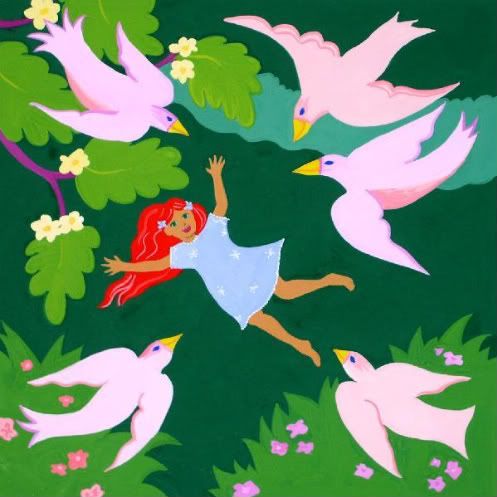
The best part, though, is the emphasis on the power of story, as it's been handed down through the generations. Young readers learn that hula is a vehicle for retelling legends about gods and goddesses, such as Pele, or chants about the history and geneaology of Hawaiian royalty (ali'i), or stories about man interacting with the natural world, such as the one included in the book, about a fisherman who's seeking the perfect place to fish. 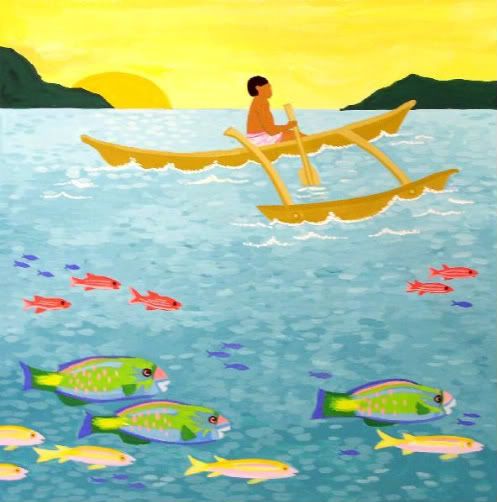
Just as pictures illuminate and extend a story, the dance movements of hula convey not only events, but essential emotions and spiritual essence. This is described in Golembe's lyrical prose:
Swim like honu
as you glide
through quiet waters
side by side.
Let your fingers bring down
afternoon rain,
and with the passing of the storm
your hands will tell the story
of a rainbow being born.
If you are not yet familiar with Carla Golembe's art, you're in for a real treat -- color-drenched pictures rendered in deep, luscious jewel tones, a naive style depicting adults and children dancing, playing instruments, and celebrating the joy and beauty of their world. Tropical fishes and flowers border some of the spreads, adding visual appeal and interest.
To round things out, there's an end note clearly outlining hula's history, with a glossary of Hawaiian words used in the text. The included CD is perfect for younger children who might like to simply listen to the story, or for beginning readers who want to follow along with the narration. It's also a wonderful way to hear all the Hawaiian words pronounced correctly by a native speaker.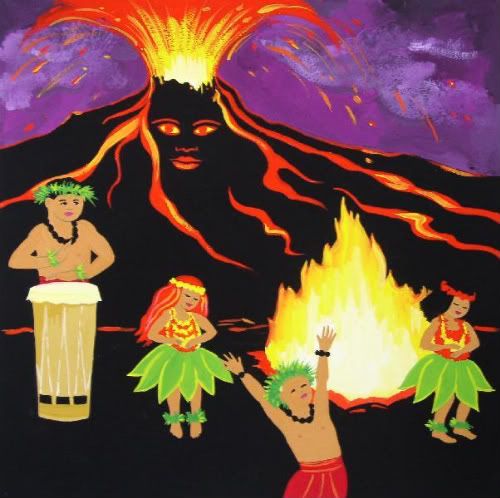
The Story of Hula won a Hawaiian Music Award (children's category), and was a finalist both for the Benjamin Franklin Children's and Audiobook Award, and Foreword Magazine's Books of the Year. It is highly recommended for any study unit on Hawaiian culture, or for anyone seeking to increase his/her appreciation for the oral and intergenerational aspects of hula.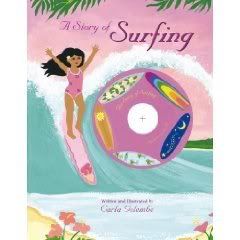 *And don't miss Carla's companion book, The Story of Surfing (Bess Press, 2006), to plunge yourself into this ancient sport of kings and queens!
*And don't miss Carla's companion book, The Story of Surfing (Bess Press, 2006), to plunge yourself into this ancient sport of kings and queens!
For more about Carla, visit her beautiful, eye-popping website!
*All interior spreads posted by permission of illustrator, copyright © 2009 Carla Golembe, published by Bess Press. All rights reserved.
Blog: jama rattigan's alphabet soup (Login to Add to MyJacketFlap)
JacketFlap tags: hawaii month, dumpling soup giveaway, Add a tag
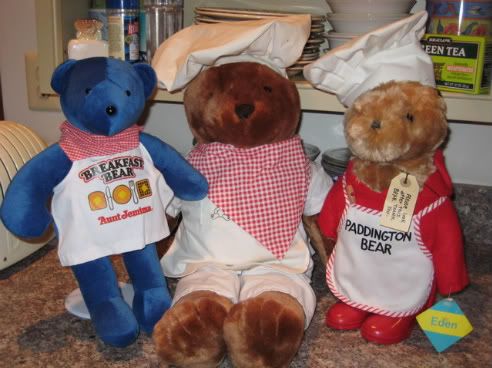
The official alphabet soup kitchen helpers have had a busy month.
At the beginning of January, they were told the most well behaved bear would get to draw the winning names in the Dumpling Soup giveaway.
Ever since then, they've done everything they can think of to impress me.
Breakfast Bear made yummy cocoa every morning.
For lunch, I got a ham and cheese sandwich (plastic never tasted so good).
Paddington was quick to help with the dishes,
and Binky pitched in with the floors.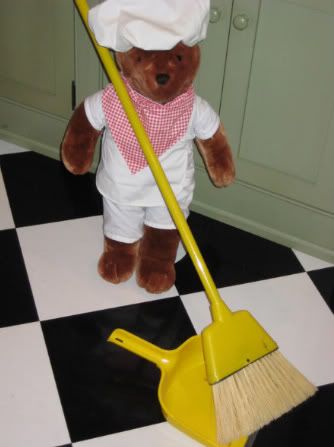
They even took a nap every afternoon without being told to.
Shortly after midnight on February 1st, we numbered every comment received on the blog (total of 236), folded them up like dumplings,
then tossed them into the big red soup pot.
We simmered the entries until they were fully cooked.
But who would pick the winners?
They had all been so good, I couldn't decide. Just in time, someone with an eloquent speaking voice chimed in.
"All bears are created equal, regardless of size or color of fur. Let them each pick a name! Let's just get this over with so we can eat some chili!"
So Breakfast Bear stirred the dumplings,
gave Paddington a turn,
followed by Binky. It was all so democratic.
Then, each closed their eyes and ladled out a winner!
And they are -- *drum roll, please*
#76: Julia ![]() viabloomington
viabloomington
#124: Kristi Valiant
#143: Debbie ![]() aome
aome
CONGRATULATIONS!!
Julia, Kristi, and Debbie, please email your snail mail addresses to: readermail (at) jamakimrattigan (dot) com.
Thanks to everyone who entered this giveaway. We truly appreciated each and every comment!! Have a good week, and Happy February!!
Blog: jama rattigan's alphabet soup (Login to Add to MyJacketFlap)
JacketFlap tags: hawaii month, peter moon band, Add a tag
Recently, while searching for a Hawaiian mele to share with you, I came across a lovely video of the Peter Moon Band (PMB) performing "Mauna Loa."
It's vintage, quintessential Hawaiiana, so typical of the "no hurry" mindset I miss so much. The sweet, sublime harmonies draw out the emotions of the lilting melody, and I was so sipping ambrosial liquid from a coconut shell and walking along the beach at sunset with Tom Selleck, when a disturbing thought occurred to me: I had no idea what they were singing about.
I guess the common assumption is that most Hawaiian songs are about green mountains, tropical flowers, palm trees waving in the breeze, and the rolling waves of the sea. Some of them probably are, but I found, much to my amusement and amazement, that this one wasn't.
Listen to the song, let it transport you, then try to guess what it's about. So deceptively sweet!
Apparently, this song is about a spurned lover, a man who's married to a promiscuous woman with hips as wide as a ship. He's giving her the final brush-off, comparing himself to the roach eaten hanky used to wipe her pointy shoes.
Hawaiians are famous for using a sly, centuries-old poetic device called kaona, or multi-layered metaphor. Innocuous images are often used to mask a not-so-innocent statement. There is much carnality and bawdiness in Hawaiian songs, and kaona allows the singer to convey double or triple entendre, with relative ease. Hence, the metaphor of the ship named "Mauna Loa," never returning to the same port.
Next time you hear a Hawaiian song mentioning rain or mist, take heed, these images are the poetic equivalent of lovemaking. *fans self*
Blog: jama rattigan's alphabet soup (Login to Add to MyJacketFlap)
JacketFlap tags: hawaii month, Add a tag
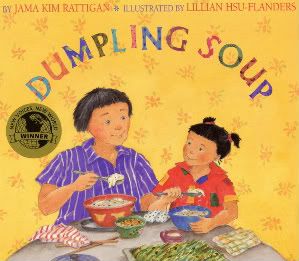 Time is running out to enter my Dumpling Soup giveaway! For a chance to win one of three signed, hardcover copies, simply comment on any post dated January 6 - 31, 2009. Enter as many times as you like. Winners announced next week.
Time is running out to enter my Dumpling Soup giveaway! For a chance to win one of three signed, hardcover copies, simply comment on any post dated January 6 - 31, 2009. Enter as many times as you like. Winners announced next week.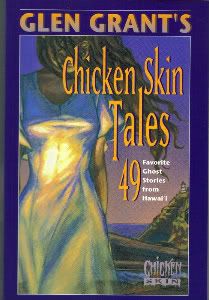 This book is still up for grabs. It's a collection of ghost tales penned by well-known Hawaiian storyteller, Glen Grant. If you're interested, please let me know in a comment, or email me at: readermail (at) jamakimrattigan (dot) com.
This book is still up for grabs. It's a collection of ghost tales penned by well-known Hawaiian storyteller, Glen Grant. If you're interested, please let me know in a comment, or email me at: readermail (at) jamakimrattigan (dot) com.
And now, a well-kept secret revealed. With this knowledge, you are officially one of the cool kids with inside info about Hawaiians few outsiders are privy to. Here (shhh!), are the three major food groups in Hawai'i:
Blog: jama rattigan's alphabet soup (Login to Add to MyJacketFlap)
JacketFlap tags: book reviews, graham salisbury, hawaii month, author profiles, Add a tag

If you asked me who's writing the very best Hawai'i-related children's fiction these days, the answer would be very simple: Graham Salisbury.
For almost two decades, I've read his short stories and middle grade novels with awe and admiration, grateful that someone has been able to accurately capture the soul, spirit, and authentic flavor of the Islands. I've read other books set in Hawai'i -- there are palm trees, beaches, and volcanoes galore, but when it comes to portraying characters who feel so believably local that I'm sure I must have known them at some point in my life, Salisbury's the man.
Part of his magic is about the language -- authentic dialogue created through the use of syntax approximating Hawaiian pidgin. This makes it real and familiar for Hawaiian readers, and accessible for mainlanders. Moreover, this haole is so in tune with his Hawaiian roots, that he's even able to seamlessly slip into the skin of another ethnicity, such as the Japanese American main character, Tomi Nakaji, in Under the Blood Red Sun (winner of the 1994 Scott O'Dell Award for Historical Fiction). 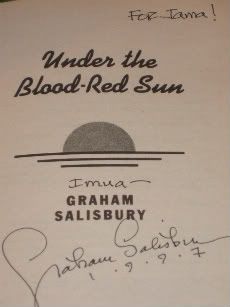
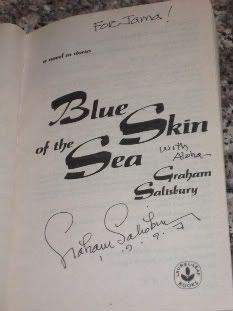
This is not to say that his stories appeal mostly to readers familiar with or from Hawai'i. Quite the contrary: Salisbury's recurring universal themes of friendship, honor, courage, and loyalty resonate with a wide range of young readers who are navigating the difficult and often painful journey of adolescence.
Of special interest is Salisbury's exploration of the father-son relationship (Lord of the Deep), which stems from his own lack of a strong father figure while he was growing up on O'ahu and the Big Island. This, along with his insightful and respectful examination of the inner life of adolescent boys (Blue Skin of the Sea), make his books quite unique, even though they are enjoyed equally by both sexes.
I just finished Graham's most recent book, Night of the Howling Dogs (Random House, 2007), which is based on the true story of a Hilo boy scout troop caught in a 7.2 magnitude earthquake and tsunami on the Big Island of Hawai'i. The story is narrated by Dylan, an eighth grader who is excited about hiking down to a remote beach at the base of Kilauea volcano with his best friend, Casey, six other scouts, and two adult leaders.

NIGHT OF THE HOWLING DOGS by Graham Salisbury,
(Random House, 2007), ages 9-12, 208 pp.
The dramatic tension is established early on, with Dylan's unease at having one of the newer scouts, Louie, on the trip. Louie, a hardened 15-year-old, had threatened Dylan years before, and still carries a big chip on his shoulder.
The hike down to the beach is difficult and challenging, and once there, Dylan first hears, then sees, two mysterious howling dogs up on the cliff. He is told that according to Hawaiian superstition, they are a sure sign something is going to happen. In the dark of night, the boys are awakened by a strong earthquake, boulders tumbling down the cliff, and then a tsunami which engulfs everything. In the fast-paced, highly suspenseful events that follow, Dylan finds himself teamed up with Louie to help rescue the others. They must depend on their wits, and establish a degree of mutual trust and respect as they face dangers they could never have imagined.
Salisbury's vivid, sensual descriptions are brilliant; nature is, after all, the primary antagonist in this survival adventure. The reader is thrust directly into the fray, witness to Dylan's visceral reactions as each new challenge presents itself. How does one deal with bloody feet walking on sharp, pointed lava? What about a swarm of ravenous wasps desperate to get at the water in your eyes? Or nearly drowning in a raging wall of water, and having your body slashed by debris? Along with the many survival tips woven into the narrative, are fascinating bits of Hawaiian superstition, legends and spooky campfire tales, which foreshadow the action and crystallize the setting.
It is not an adventure anyone would want to experience in real life, but Salisbury has taken the reader quite close to the edge. An endnote describes actual events occurring on November 29, 1975, with the chilling revelation that Salisbury's own cousin, Tim Twigg-Smith, was one of the scouts who survived that fateful day. Graham convinced Tim to return to the Halape camp site just five years later, so he could see what had always been a peaceful, pristine area for himself. After encountering stinging ants, flying roaches, and blinding heat, he was able to imagine the events that eventually turned into this marvelous book.
Night of the Howling Dogs has earned many well deserved accolades, including the 2008 Bank Street College of Education Book of the Year, Junior Library Guild Premier Selection Award, NYPL 100 Best Books for Reading and Sharing, and the 2007 NAPPA Gold Award. And the ultimate proof of its worth? I hate camping, but I loved this book! :D
Read an excerpt from Night of the Howling Dogs here.
The YaYaYa's interview Graham here.
For more information about the 1975 earthquake/tsunami, including a photo of the real campers, click here.
My teacher friend, Fran, librarian friend, Sylvia, and I are unanimous in our praise and recommendation of Graham Salisbury's books:
Blue Skin of the Sea
Shark Bait
Jungle Dogs
Under the Blood Red Sun
Lord of the Deep
Island Boyz
Eyes of the Emperor
House of the Red Fish
Night of the Howling Dogs
Check out Graham's website for teacher guides, more book excerpts, and the skinny on his accomplishments as a rock musician in the 60's!
Blog: jama rattigan's alphabet soup (Login to Add to MyJacketFlap)
JacketFlap tags: hawaii month, kathleen wong bishop, leslie ann hayashi, alphabetica, book reviews, Add a tag
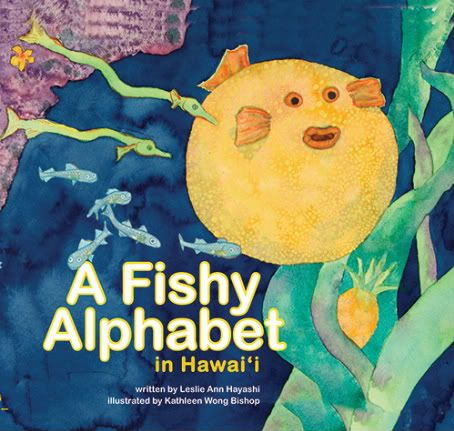
A Fishy Alphabet in Hawai'i, by Leslie Ann Hayashi,
pictures by Kathleen Wong Bishop (Mutual Publishing, 2007),
Picture Book for ages 4-8, 32 pp.
Calling all fish lovers!
Whip out your good time goggles and dive straight into this playful book!
Leslie Ann Hayashi and Kathleen Wong Bishop, long time pals from Wahiawa (the unheralded center of the creative universe), really know how to make a splash when it comes to the alphabet.
Did someone just say alphabet? Hold me down, please.
A Fishy Alphabet in Hawai'i (Mutual Publishing, 2007), is my fave Hayashi/Bishop book. Um, maybe I'm just a tad partial to alphabet books. You think? But this one just makes me happy all over. This usually happens when I'm confronted with page after page of vivid, pulsating, color-drenched pictures teeming with life. Thank you, say my eyes. We can't get enough of those sizzling orange-reds, seaweed hunter greens, and shocking lemon yellows. And dang, did you notice all those fishy facial expressions?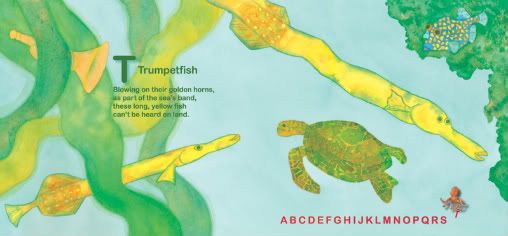
For each letter, a different fish -- gliding, wubbling, darting through the slippery pages of this book. Most go by their common names -- Pufferfish, Eel, Angelfish, Moorish Idol -- but there's one scientific gilly in the bunch, Xyrichtys Pavo, to keep all the others in line, and of course there are a few rascals who like to show-off their Hawaiian names -- 'Iao, Kikakapu, and the infamous Humuhumunukunukuapua'a. (Say that three times and you get extra chocolate.) Onaga, who likes his Japanese name instead of his Hawaiian (ula 'ula) or common name (red snapper), is the tastiest one of the bunch.
Little ones will eat up the four-line rhymes capturing the essence of each fish:
Goatfish
Known for its bear,
which tickles its chin,
if you haven't seen one,
where have you been?
Queen Parrotfish
The Queen Parrotfish,
with her crown of greens and blues,
shimmers in the light,
revealing splendid hues.
Then, they'll have a ball looking for the fun surprises on each page -- objects not usually found in the ocean hanging out on their corresponding alphabet pages simply because they want to: an angel mermaid patting an angelfish, an Easter egg nestled on a rock ledge tempting an eel, a volcano rumbling near a velvetfish, even a lonely zucchini teasing the zebra rockskipper. A list of hidden words at the back of the book is great for building vocabulary and prompting closer observation.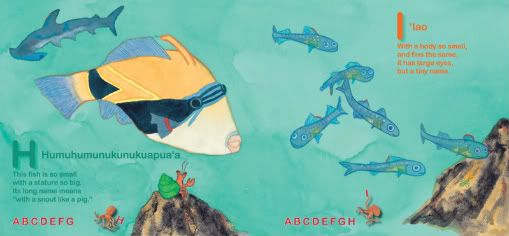
Did I already mention the fishy expressions? Kathy has done a fabulous job of giving these sea creatures personality. Her depictions are fetching, endearing, soothing, winsome.
I highly recommend you grab your net and scoop up this book. You can purchase it through Booklines Hawai'i, or from your favorite online bookseller. It's definitely the catch of the day!

Look what else I snagged:
A yummy recipe from Leslie herself, who says, "I'm a soccer mom (my younger son plays), and whenever we have potlucks, I bring this dessert. It's a great hit as I'm usually asked for this recipe!"
GUAVA OR ORANGE JELLO SQUARES/RECTANGLES
6 packages Knox Gelatin
1 cup sugar (I actually use 3/4 cup)
1 box strawberry jello
2 tsp. lemon juice (optional)
12 ounces guava juice concentrate
2 cups cold water
4 cups boiled water
Start with 2 cups of cold water in a large bowl.
Add 2 packages of Knox Gelatin, one at a time, or it will get very lumpy.
Add sugar.
Add Jello.
Add boiled water.
Stir in frozen juice concentrate.
Add lemon juice.
Pour into 9 x 13 x 2 inch pan and refrigerate overnight. The jello can be cut into squares or rectangles and served in separate cupcake paper cups or just served from the pan.
Substitution: If guava juice concentrate is not available, you can substitute frozen orange juice concentrate and 1 box of orange jello instead of strawberry.
*What is great about this recipe is that unlike regular jello, this treat can actually stay out for hours and not lose its shape.
If you missed the other post about Leslie and Kathy's books, click here.
Be sure to check out their charming website -- these ladies make adorable mermaids!
*Interior spreads posted by permission, copyright © 2007 Kathleen Wong Bishop, published by Mutual Publishing. All rights reserved.
Mahalo, Courtney!! Certified authentic Alphabetica. Handmade just for you with love and tartar sauce.
Certified authentic Alphabetica. Handmade just for you with love and tartar sauce.
Blog: jama rattigan's alphabet soup (Login to Add to MyJacketFlap)
JacketFlap tags: barack obama, hawaii month, Add a tag
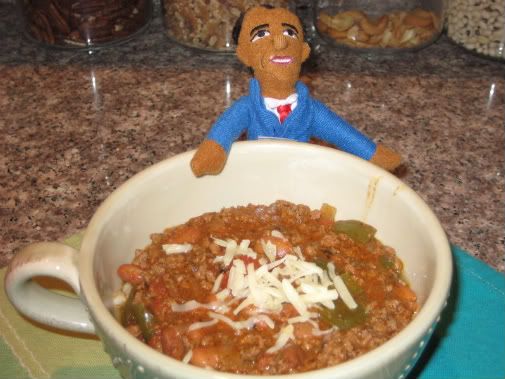
Happy Inauguration Day! So exciting!
I know you'll be busy watching the inaugural ceremony and parade on TV and all, but NOW HEAR THIS: in order to properly celebrate this momentous occasion, this defining moment, this day when America turns on its axis -- there is one thing you absolutely have-tuh do:
EAT CHILI!
That's right! As I mentioned when I posted his recipe awhile back, chili is Barack's favorite thing to cook. It makes perfect sense, too -- an easy crowd pleaser, infinitely adaptable whether you're a carnivore or vegetarian. Everyman's food.
There is one thing, though: Barack's chili (pictured above with ground beef), is surprisingly bland. No salt or tomato sauce was listed in the recipe ingredients. I know there are as many kinds of chili as there are people, but I did think the omission of salt was strange. Maybe that's why he's President and not a professional chef!
Anyway, it doesn't matter whether you doctor up Barack's recipe, use your own, open up a can, or grab a bowl of the stuff at your favorite restaurant -- just as long as you eat some (over rice). Yes, it's your civic duty!
And for dessert, indulge in some of this special Ben and Jerry's ice cream, renamed just for the month of January in honor of Barack Obama. It's available in scoop shops around the country -- "amber waves of buttery ice cream with roasted non-partisan pecans." All proceeds from its sale goes to the Common Cause Education Fund.

While your chili is on the simmer, take this Jeopardy style quiz to see just how much you really know about our new President.
Just last week, Barack was spotted at Ben's Chili Bowl in D.C. (see video).
This cool video featuring the Obama song will get you movin' and shakin' (thanks, Jules)!
Also, this is a very interesting website covering Barack's Hawai'i connections -- places he lived, schools attended, etc. Thanks to James for the link!
For the official Inauguration Day Schedule, click here.
Change we can believe in:
Yesterday = chicken in every pot
Today = chili in every bowl.
Hot stuff!
Blog: jama rattigan's alphabet soup (Login to Add to MyJacketFlap)
JacketFlap tags: hawaii month, fried rice, fran wong, Add a tag
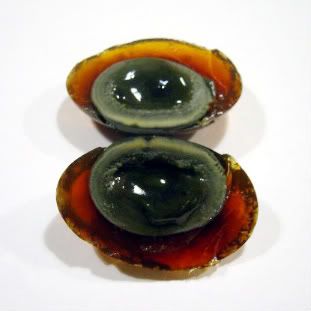
Friends, do you know what this is?
It looks perfectly innocent, doesn't it, sitting there in all its ashy gray-black glory?
Hah!
Don't be fooled. Just be glad you don't have smell-a-vision (unless you covet the odor of sulphur and ammonia).
Once, long ago, in my foolish salad days, someone made me eat this Chinese delicacy, the thousand-year-old duck egg. And this someone just happens to be here today, visiting from her warm abode in Honolulu, Hawai'i!
Fran and I went to grad school together. Most days, we'd share chicken and kamaboku (fish cake) sandwiches in the English Department library. After graduation, we continued to meet for lunch, the deal being to try to introduce the other person to something she had never eaten before.
That's how we became "Colleagues in Adventure" (CIA's).
It started out quite well. Fran invited me over for artichokes. I learned to dip those little green leaves into savory dressing and scrape the meat off against the roof of my mouth. A lot of work for so little food. We called it the "Artichoke Adventure."
This was followed by the "Strange Adventure from Sour to Sweet." I took Fran to a restaurant. I forgot what we ate and why the whole thing was strange. Ask Fran.
Then came (*gag*) the "Duck Egg Disaster." *Fran laughs maniacally* She came to my place of employment, a business office located in a downtown Honolulu highrise. You know, I should have known better. She had a devious smile on her face as she presented her innocent little brown bag. She led me to the ladies room, where she took out two eggs encased in mud and straw.
How interesting! I'd always loved Chinese food, and had eaten the regular salted duck eggs many times.
Then she cracked them open. Holy stink!!
Try to imagine the worst smell in the world concentrated in a small restroom without windows. "Go ahead," she said. "Eat your egg."
Easy for her to say. She wasn't the one who had fainted dead away on the floor.
There was no getting around it. I would have to eat some egg. It would have been rude to refuse. I foolishly thought the white (actually gray) part of the egg would be easier to swallow than the yolk. Nope. It tasted like gelatinous underarms. The smell was so pervasive, the entire floor reeked of it. Office workers wrinkled up their noses in dismay. I denied any involvement. Who would have thought there was something more odorous than kim chee?
And yet, we're still friends. Thankfully, Fran didn't bring any duck eggs today, but the delicious recipe for her famous fried rice. She and her husband, the Silent One, eat this for breakfast at least once a week. Since Fran is a souper douper award winning teacher, she went above and beyond and sent along step-by-step photos. Enjoy!
WONG'S ALL IN ONE PAN FRIED RICE
In the islands, fried rice is a favorite local dish. It satisfies our love of rice as the predominant starch consumed daily -- easily at breakfast, lunch, dinner and even for snack! Fried rice is a wonderful conglomerate of the best of island flavors because it pleases the taste buds of our many cultures. Best of all, it is made in one frying pan, wok, or dutch oven. Although the rice, egg, and green onions are the basic foundation of this recipe, the meat, and sometimes, the vegetables, provide an infinite number of ways to prepare this dish. Here are some of the favorites, which you can use alone, or mix and match:
CHINESE: Lup cheong (Chinese sausage), char siu (red roast pork) or roast pork.
KOREAN: Kim chee (spicy, pickled cabbage, cut into small pieces)
IRISH: Canned corned beef (add about 1/3 to 1/2 of the can)
AMERICAN: Sausages of all kinds, ham and spam (islanders have a love affair with SPAM), some frozen peas, a little canned corn.
PORTUGUESE: Portuguese sausage (either mild or hot)!
HAWAIIAN: Kalua pork (shredded pork that can be made in the oven using a smoked seasoning)
FISH LOVERS: Canned salmon (about 1/3 to 1/4 of a can) seasoned with a little garlic salt. Add salmon into the beaten egg, then fry together.
VEGETARIAN: Top the rice with small blocks of tofu, which you can lightly cook first in oil and season with oyster sauce or soy sauce.
Many households use whatever is in the fridge, combining various leftovers into the dish. The best thing about fried rice is that it's a great way to make a new meal using what you already have -- all you need is a little imagination!
Ingredients:
2 cups cooked rice
3-4 large eggs
green onions (about 5-6 stalks or add according to taste)
meat (of your choice, cut in small pieces)
veggies are optional (kim chee, canned corn, frozen peas)
cooking oil
1-2 T oyster sauce (season to taste), or soy sauce
slight sprinkle of Hawaiian sea salt (optional)
Steps:
Cut meat and green onions into small pieces.

Crack and beat eggs (if you're using canned salmon, add it before cooking eggs).
Add about 1 T milk or water to dilute the eggs.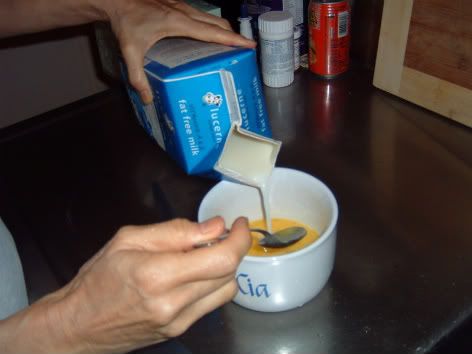
Add 1-2 T vegetable oil to a large frying pan and heat.
Add eggs and scramble. 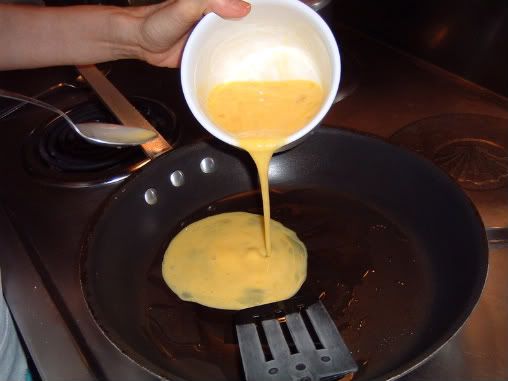
Break the eggs into small pieces as you cook, using your spatula.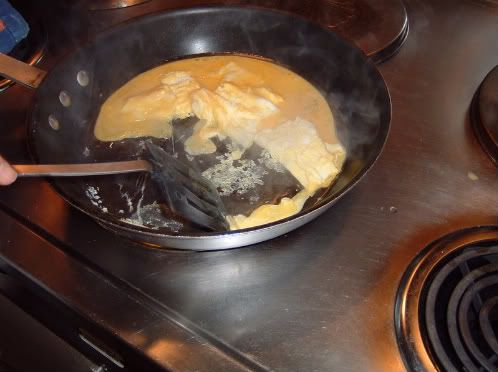
Add the meat and green onions. 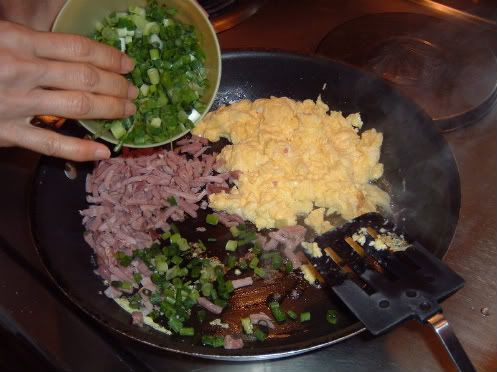
Stir fry them together.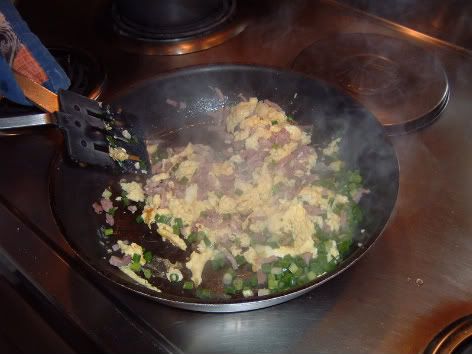
Add veggies, if desired.
Gradually stir in the rice (precooked) with the ingredients. Cook until rice is soft.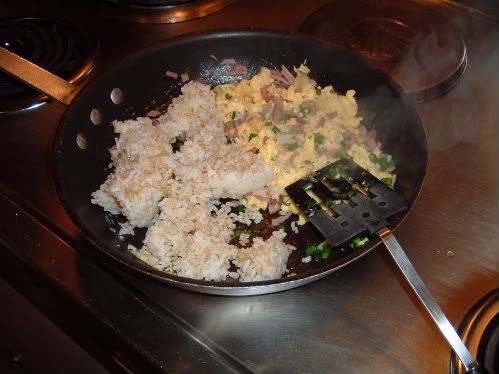
When everything is mixed, season with oyster sauce or soy sauce.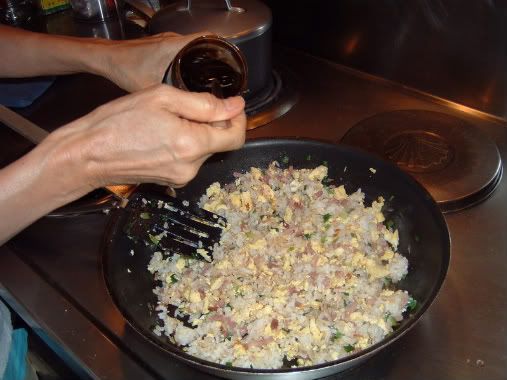
Serve hot.
*With your tummy full, you'll need something to read. Here are Fran's Hawai'i-related book recommendations:
Picture books:
The Musubi Man: Hawai'i's Gingerbread Man, by Sandi Takayama, pictures by Pat Hall (Bess Press, 1997).
How Maui Slowed the Sun, by Suelyn Ching Tune, pictures by Robin Yoko Birningham (University of Hawai'i Press, 1988).
The Story of Chinaman's Hat, by Dean Howell (Island Heritage, 1990).
A is for Aloha, by U'ilani Goldsberg (Sleeping Bear Press, 2005).
The Three Little Hawaiian Pigs and the Magic Shark, by Donivee Martin Laird (Barnaby Books, 1990).
How the B-52 Cockroach Learned to Fly, by Lisa Matsumoto, pictures by Michael Furuya (Lehua, Inc. 1995).
Sumorella: A Hawai'i Cinderella Story, by Sandi Takayama, pictures by Esther Szegedy (Bess Press, 1997).
For middle grade readers:
The titles of Graham Salisbury, especially Blue Skin of the Sea (1994), Eyes of the Emperor (2007), and Under the Blood Red Sun (2005), all published by Laurel Leaf paperbacks.

Thanks, Fran and Jack!!
Blog: jama rattigan's alphabet soup (Login to Add to MyJacketFlap)
JacketFlap tags: poetry friday, geraldine heng, hanapepe, hawaii month, Add a tag
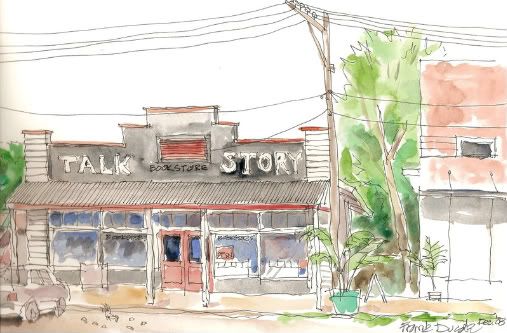
Watercolor by Frank Ducote.
Still waters run deep.
Consider the small, quiet town of Hanapepe (hah-nah-PEH-peh), on the island of Kaua'i, which is the northernmost and oldest of Hawai'i's eight main islands. I had never been there, until I read this poem:
HANAPEPE, KAUA'I
by Geraldine Heng
january does not awaken this town.
this skin of stillness has lain quiet now
for gentle lifetimes.
the houses, like colored wooden make-believe
sit perennially charming in picture frames,
in the metal reflection of a family car.
sunlight, teeming with dusty life
warms the storefronts, yellowly.
in shadowy interiors, proprietors measure
condiments and words, their greeting a secret meeting
shy as deep water, the memories of this town,
dimly glimpsed in the glass jars.
and a modest dance studio waits down the road
now serene, once eager perhaps
with impatient feet quick for the new steps
perhaps the doctor in the clinic danced them.
perhaps once the two old friends
dreaming gently over ice-shop counter
waxed companionable moustaches
in steamy barbershop mirror,
while their wives, tired by children, softly complained.
holiday visitors come this warm afternoon
in bright voices, chasing weekend lives
they leave the sound of feet on bare boards.
in the evening the young gathered at jukebox and pool tables.
the movie house plays a lone feature.
soon, february passes unnoticed by the soda fountains.
- from Island Fire: An Anthology of Literature from Hawai'i, edited by Cheryl A. and James R. Harstad (University of Hawai'i Press, 2002).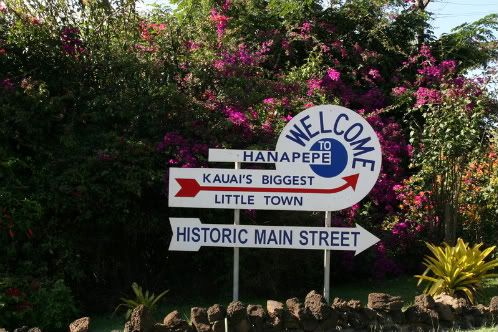
It's fun to wander small, quiet towns and imagine what might have happened there at one time. This sign, proclaiming Hanapepe as "Kauai's Biggest Little Town," made me very curious.
I did a little investigating and discovered that Hanapepe ("crushed bay"), back in the day, was quite a place. It was founded by some Chinese rice farmers in the late 19th century, and was the only non-plantation town in the area. It once housed opium dens and was known for its rowdy bars and brawls. There was even a massacre here in 1924, where the police shot and killed 17 Filipino sugar cane workers who were on strike. And do you remember "The Thorn Birds," with Richard Chamberlain? Some of it was shot here, and scenes from "Jurassic Park" were shot in the surrounding valley. Who knew?
In 1992, Hanapepe was decimated by Hurricane Iniki. But this little town has come back. Its rich past, charm, and quirkiness still lures the curious, and creative souls have found a haven here. 
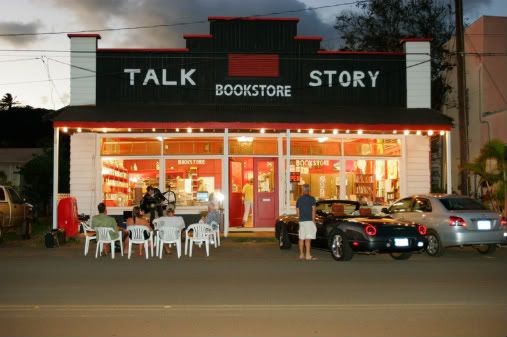
Talk Story is the western-most bookstore in the U.S.
Today, main street houses a few art galleries, gift shops, eateries, and the coolest bookstore/cafe evah -- Talk Story, which is a friendly gathering place, and the home of 1500 used, new, rare and collectible titles. Every Friday night, it's Indian food and live music. You can even buy locally-made gifts and jewelry, Hawaiian records, or take slack key guitar or ukulele lessons there.
Isn't it cool that despite everything this little town has been through, "the printed word" still thrives? English was first heard in the Hawaiian Islands when Captain Cook stepped ashore on Kaua'i in 1778. I love that if you travel just about as far west as you can in the populated U.S., you'll find an indie bookstore there! 
You know, it is Friday. I was thinking -- why don't we all zip on over to this funky spot, and hang out tonight? They've got art, music, books, and food. Who could ask for more?
In case you're thirsty: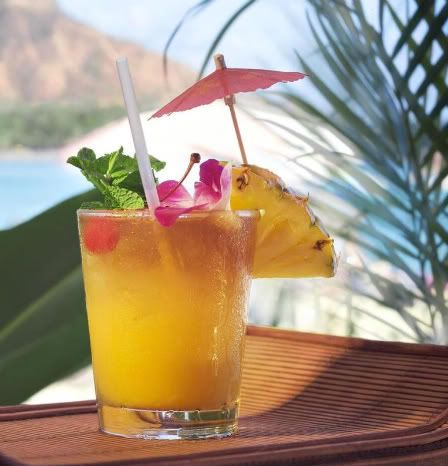
The poetry goddess hosting today is the lovely Karen Edmisten. Cruise on over for the roundup. She's got coffee!
Master Poetry Friday schedule is at Big A little a.
Visit the alphabet soup 2008 Poetry Friday archive here.
*Thanks to Ed and Cynthia of Talk Story for permission to post photos of their bookstore!
Blog: jama rattigan's alphabet soup (Login to Add to MyJacketFlap)
JacketFlap tags: barack obama, hawaii month, pidgin english, Add a tag
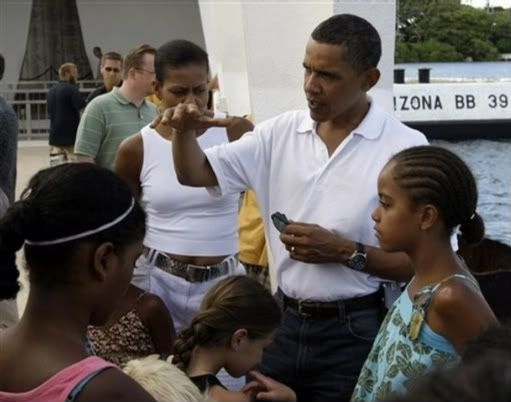
The Obamas visiting the U.S.S. Arizona last year.
So, the past few days I've been wondering something.
When orator extraordinaire Barack Obama is in Hawai'i, does he ever speak any Pidgin? I mean, can you imagine him saying something like:
Ho, dis haupia cake broke da mout!
We go holoholo bumbai.
No can.
It's hard to imagine, but I tend to think he must speak some Pidgin when he's with old friends. I haven't lived in Hawai'i for 30+ years, and I never speak Pidgin here in Virginia, yet whenever I'm back home visiting family and friends, I naturally begin to shorten my phrases and assume that unmistakable Pidgin "accent." It's in my DNA, and I think it's in Barack's, too. Len wholly disagrees, citing that Barack is too conscious of his public image to utter so much as a syllable in Pidgin, since the press would pick up on every word he says.
Like Pidgin is bad, or something? Not so.
Pidgin, or Hawai'i Creole English (not to be confused with the Hawaiian language), is spoken by most of the local population. If ever a common language anywhere had the power to both characterize and continually unify an ethnically diverse society, Hawaiian Pidgin is it. Dynamic, energizing, colorful, varied and sassy, this homegrown style of talk has persisted in the islands for over 200 years, despite organized efforts to suppress it.
Pidgin evolved out of sheer necessity as outsiders arrived in the islands, from early English traders to New England missionaries to plantation workers from such countries as China, Portugal, Japan, Korea, and the Philippines. Each group brought its own words, idioms, rhythmic speech patterns and grammatical idiosyncrasies to bear upon a shortened form of Standard English, thereby facilitating communication.
You lolo o' wat?
Going get plenny kaukau.
Dat guy wen kakaroach me!
In short, Pidgin cut to the chase, and enabled a lot of people, living in a small place, to get along. It continues to evolve today, even blending elements of contemporary slang, as the need arises.
Mosh mosh!
Dis ting stay kapakahi.
Eh, no wear yo rubbah slippahs in da house.
Although Hawai'i Creole English (HCE) embodies the very identity of island residents, there is lingering ambivalence over its use. Some view it as inferior broken English, saying those who speak it are deficient in some way and that it impedes mastery of Standard English in children.
Thanks to the efforts of ESL educators and the use of Pidgin in poetry, songs, essays, and plays in the last few decades, HCE is now recognized as a distinct language -- not a substitute for Standard English, by any means, but a language that honors cultural identity. It's definitely here to stay, and it reflects the inestimable value Hawaiians have always placed on inclusion, cooperation, and finding common ground. Moreover, it's totally non-hierarchical, the great equalizer that cuts across race, gender, and socio-economic class.
Sounds like Barack, no?
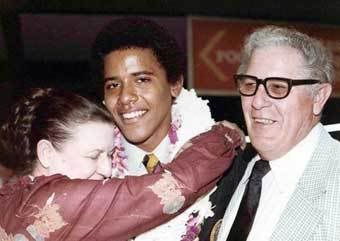
No doubt Barack heard and spoke Pidgin to some degree while growing up. He might not speak much of it now, but it certainly enabled him, in his formative years, to communicate with and understand people from many different cultures, and to value their differences. As Michelle said, "In order to understand Barack, you have to understand Hawai'i." And, in order to fully understand Hawai'i, it helps to know Pidgin, or at the very least, to recognize the crucial role this particular language has played in its social history. 
So, I'm still having fun imagining Barack hanging out with his old Punahou school buddies and talking story about the old days. Wouldn't some linguistic flavor from the past subconsciously emerge?
Instead of, "Shall we get a bite to eat?", might he say, "Eh, you guys like go Rainbow Drive Inn?" Or, would he say, "Dat buggah was wrong, man," instead of, "I've never agreed with Bush's decision to invade Iraq."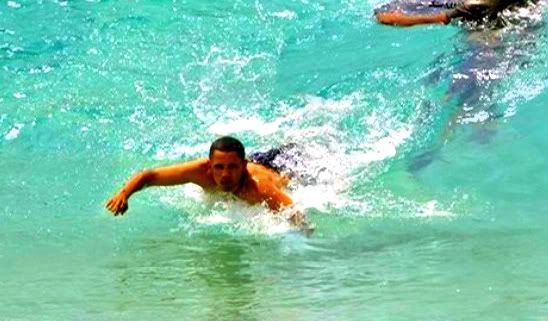
No, no, maybe not. He's polished his official image so perfectly that it's really hard imagining him relaxing his speech. Yes, but he is the most accessible President, the most down to earth we've had so far. No, I can't decide, though I know he'd never say, "No can." What do you think?
Now, if I could just figure out why he always says "tuh," instead of "to!"
Like learn mo' ?
Da Kine Dictionary, compiled and edited by Lee A. Tonouchi (Bess Press, 2005). Essential Pidgin expressions and terms, sentence examples, and colorful photos showing local people in funny-kine poses.
Pidgin Grammar: An Introduction to the Creole Language of Hawai'i, by Kent Sakoda and Jeff Siegel (Bess Press, 2003). Details origins and uses, pronunciation, writing system, word classes, phrases and types of sentences. Puts to rest the idea that Pidgin is merely a form of broken English without a structure.
Pidgin to the Max: 25th Anniversary Edition, by Kent Sakata and Pat Sasaki (Bess Press, 2005). Simply hilarious, with situational cartoon drawings. A classic, and essential for anyone who seeks true insight into local Hawaiian culture.
Da Jesus Book: Hawai'i Pidgin New Testament (Wycliff Bible Translators, 2000). And they said it couldn't be done!
Da links:
Position Paper by Da Pidgin Coup (University of Hawai'i). Discusses the role of Pidgin in education, and the complex relationship between Pidgin and English.
How to Talk Conversational Pidgin: a list of common expressions, their definitions, and audio files on pronunciation. A great primer.
Check out this video to hear a short conversation about Gabby Pahinui, slack key guitar pioneer. Hearing them talk, I feel like I know these guys, even if I don't. The power of pidgin makes me feel like I'm home.

Pidgin phrases in this post:
My goodness, this coconut pudding cake is delicious!
Let's go out (cruising) later.
That's impossible.
Are you crazy?
There's going to be lots of food.
That man cheated (robbed) me!
Shortened form of moshi moshi (Japanese for "hello" when answering the phone)
This is all mixed up (upside down, backwards).
Excuse me, please don't wear your flip flops indoors.
Tanks, eh?
Blog: jama rattigan's alphabet soup (Login to Add to MyJacketFlap)
JacketFlap tags: book reviews, poetry friday, chocolate truffles, hawaii month, erin eitter kono, hula lullaby, Add a tag
1/2 lb. bitter sweet chocolate (preferably Belgian) 10 tablespoons unsalted butter (preferably Irish) crushed almonds Melt chocolate and butter over simmering water. Refrigerate until firm. Scoop 1/2 inch balls and roll in hands until round, drop into crushed almonds and roll until coated. Try not to eat all in one sitting. Can also substitute almonds with other nuts, or cocoa.
"In Hawai'i the warm breeze often carries the sound of the ocean waves, the rustling leaves, and the rhythmic chants of the hula. It is not difficult to imagine rocking one's child, or keiki (keh kee), to sleep to the accompaniment of this gentle cadence." ~ Foreword, Hula Lullaby, by Erin Eitter Kono.
HULA LULLABY by Erin Eitter Kono (Little, Brown, 2005),
picture book for ages 4-8, 32 pp.
I first heard about Hula Lullaby when Sam Riddleburger interviewed Erin Eitter Kono for Robert's Snow: Blogging for a Cure 2007, organized by Jules and Eisha at 7-Imp.
High quality picture books about Hawai'i always get my immediate attention because they are so few and far between. This one just happens to be beautifully produced and culturally authentic, making it even rarer and cause for unabashed adulation.
Hula Lullaby is pitch perfect -- from the title page, awash in deep, Prussian blue and graced by red anthuriums, to the Foreword spread, set against the red-orange sky of a Hawaiian sunset, to the simple, soothing, repetitive rhyme of the lullaby itself, as it enfolds the reader in its warm, tropical spell:
Come little keiki
Crawl into my lap
Listen to the ipu
thump tap thump-a-tap.
See the fire's glow
Toss its golden light
Watch the dancers sway
Against the starry night.
There is a wonderful feeling of completeness here, a reverence for and connection to the natural world, which is underscored by a prevalence of round/circular images -- mother's arms caressing her child, hula skirts, lei, waves, moon, flowers. The lilting chant is accompanied by instruments made from natural materials -- a pahu, or drum made from a hollowed tree, an ipu heke, made from two gourds, and the pu'ili, bamboo rattles.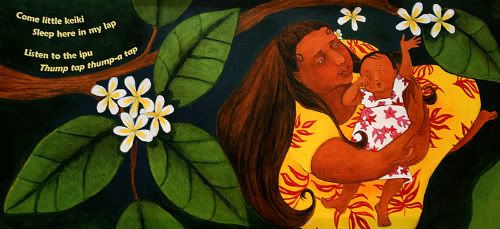
The reference to sky, mountain, land, and sea reminds me of a well-known chant by Hawaiian translator, enthnographer, and composer, Mary Kawena Pukui, entitled, "Behold," which is often taught to grade school children.
Above, above
all birds in air
Below, below
all earth's flowers
inland, inland
all forest trees
seaward, seaward
all ocean fish
sing out and say
again the refrain
Behold this lovely world.
In Erin Eitter Kono's entrancing book, the whole world partakes in this nighttime symphony.
The primitive acrylic and pencil illustrations are rendered in lush jewel tones, remniscent of Tahitian paintings by Gauguin. The movement of the dancers, the rolling and crashing of the sea waves, and the drift of warm breezes, all perfectly complement the pacing of the text, as the mother rocks, rocks, her baby to sleep. I love the sensual detail, too -- smell of the sea, fragrance of flowers, sounds both natural and manmade, which further envelops the reader in its comforting embrace.
Hula Lullaby received the Excellence in a Picture Book Award from the Children's Literature Council, and was named Best Lullaby and Goodnight Book by Nick, Jr. Magazine. Because of the traditional hula instruments (explained briefly in the Foreword), various Hawaiian flora and fauna, and its lyric beauty, this book, aside from being a lovely bedtime story, is an excellent resource for general Hawaiian study.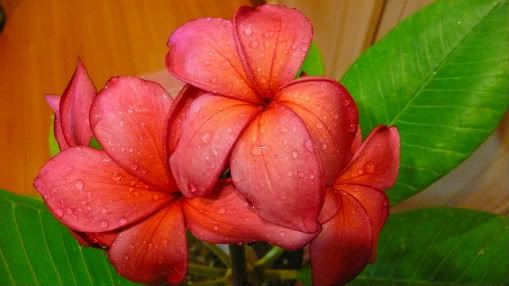
*As a special treat, Erin has agreed to share one of her favorite recipes, Chocolate Truffles! She says it's not Hawaiian, but "really really good." Since it calls for Belgian chocolate, I need no convincing. Now, this is what I call the perfect way to sweeten the new year!
CHOCOLATE TRUFFLES
from Erin Eitter Kono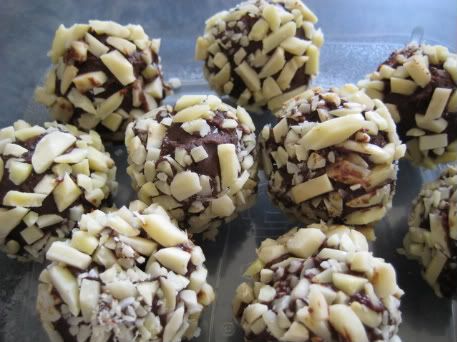
Thanks, Erin!!
For more about Erin, visit her website or blog, and read this great article at THonline.com.
For more about Mary Kawena Pukui, see my Poetry Friday post here.
And be sure to check in with Anastasia Suen's Picture Book of the Day for today's Roundup!

**Interior spreads posted by permission, copyright © 2005 Erin Eitter Kono, published by Little, Brown. All rights reserved.
Blog: jama rattigan's alphabet soup (Login to Add to MyJacketFlap)
JacketFlap tags: hawaii month, portuguese bean soup, Add a tag
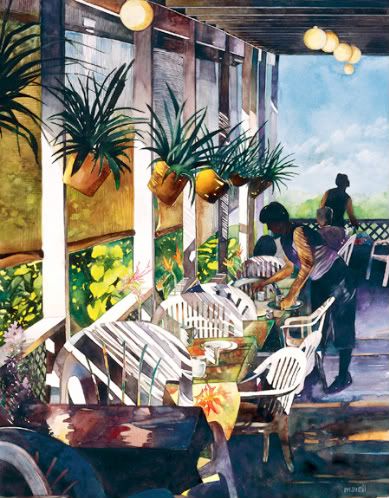
"Breakfast at the Aloha Cafe," by Beth Marcil.*
Howzit! You're just in time.
I saved a table for you right here out on the lanai. Please take a seat and make yourself comfortable! What a lovely day. Can you feel that gentle ocean breeze caressing your cheek?
Hope you're hungry, because today I've got soup! I would be very remiss if my first recipe of the new year wasn't a bowl of soup, especially since January is National Soup Month and all.
Since we're all about Hawai'i, I'm serving a local favorite: Portuguese Bean Soup. My long-time friend, Lynn, gave me this recipe eons ago, and it's still one of my all-time favorite homemade soups. It's usually made with Portuguese sausage, which is widely available in Hawai'i, but I've substituted other spicy sausages with good results. Feel free to experiment with your own favorites.
The recipe is easy to make, but requires planning ahead because it needs to simmer for several hours. Once all the ingredients are in the pot, you just need to give it a little stir now and then. It's the perfect weekend meal, a nice hearty bowl of goodness for a cold winter's day. I made a big pot recently and it was "real ono." Enjoy!
PORTUGUESE BEAN SOUP
1 16-oz can kidney beans, with liquid
2-3 lbs. ham hocks
2 cloves
2 stalks celery, chopped
1 15-oz can tomato sauce
2 peppercorns
8-9 cups water
1 onion, chopped
2 bay leaves
1 tsp. worcestershire sauce
2 T catsup
1-2 T sugar
garlic salt and pepper (to taste)
Combine above in large pot. Simmer 2-1/2 hours.
Remove meat from bones and cut into small pieces.
Then add 1 ring sausage (spicy), 1 potato, 2 carrots (pared and sliced), and 1 small cabbage (chopped).
Cook another 1-1-/2 hours. Add 1/2 cup salad macaroni (which has been pre-soaked in water 1/2 hour), 1/2 hour before the soup is finished.
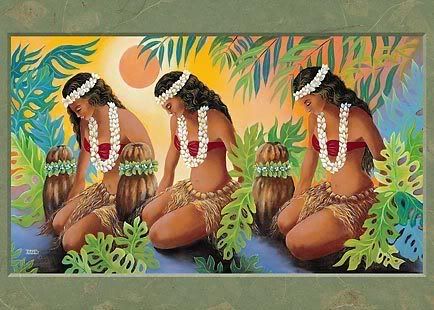
To read more yummy, sometimes amusing, and positively fascinating soup posts, click here.
To see all the soup recipes featured on this blog, click here.
*Beth Marcil's painting is available as a fine art print at HawaiiArt.com.
*Aloha Cafe image copyright © 2008 HawaiiArt.com. All rights reserved.
Blog: jama rattigan's alphabet soup (Login to Add to MyJacketFlap)
JacketFlap tags: hawaii month, dumpling soup giveaway, Add a tag
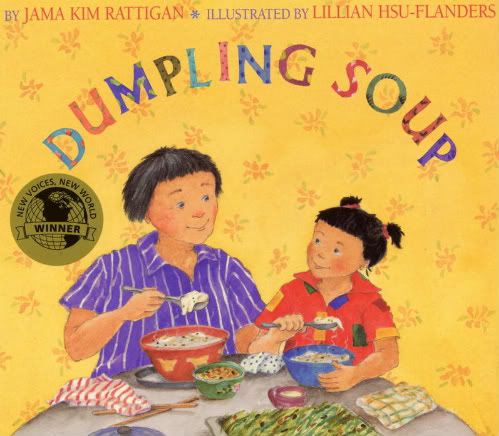
Happy 15th Birthday, Dumpling Soup!!
Wonders never cease -- my little picture book is still in print after all these years!
To spice up my Hawai'i celebration this month, I'm giving away three signed hardcover copies! These are original trade editions from my personal stash (currently, only paperback and library editions are still in print). This seems like the right time to part with them, as a way of thanking you for all your support and interest in my books and this blog.
All you have to do is comment on any post between now and January 31st, and I'll toss your name into my big red soup pot. Enter as many times as you like. Each comment = one entry. On Monday, February 2nd, the most well-behaved teddy bear in the kitchen will ladle out the winners! (Note: This giveaway is open to everyone, with or without a blog. Please include your first name and last initial if you're logging in as "Anonymous." Non U.S. residents also welcome to enter.)
And now, for your nibbling pleasure, HOW I COOKED DUMPLING SOUP (which is a story about celebrating the New Year in Hawai'i):
Well, you know me. It all began with hunger pangs.
I lived in Virginia, but my favorite dumplings lived far away in Hawai'i. No, I couldn't make them myself. It just wouldn't be the same. But I could write about them.
So, I started pre-cooking, with a few notes: 
which became an essay published here:
Good for an appetizer, but didn't satisfy me for long. I wanted a bigger serving!
Could I turn the essay into a children's book? I stirred a few ideas around via webbing and clustering,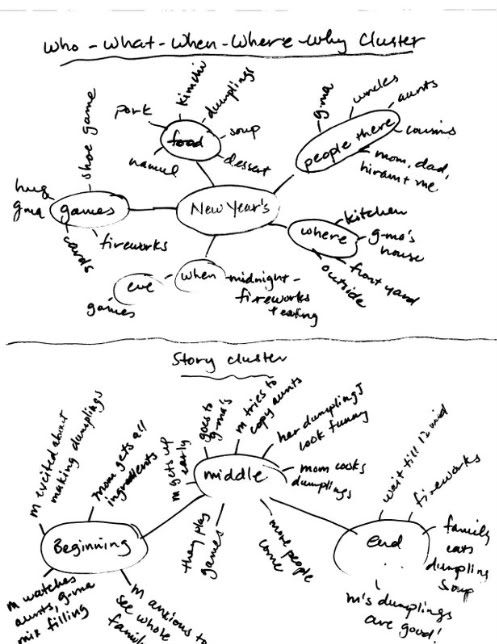
until I came up with a draft, which I chewed on for awhile. Since it was my first picture book, I didn't see the parts that were raw or half-baked.
Early DS draft.
But I sent it out anyway. Form rejections blackened my mailbox, but I kept sending it out. Then, one day, I received my first little nibble; what a delicious crumb!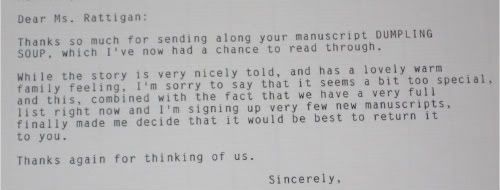
Macmillan, I still don't know what you mean by "too special."
I read the letter carefully, added a few new ingredients to my story, then received an encouraging response from another editor: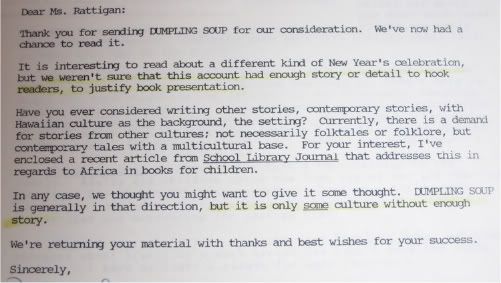
Houghton Mifflin wanted more detail, but wasn't it kind and generous of the editor to enclose that SLJ article? Turns out, they bought my second book.
Back to my antique computer (no mouse, no internet!) for more tweaking. Plot (still my weakest area), definitely needed reworking. All the writing books I read back then never mentioned "story arc." These days, that's all I hear about.
The next time I submitted it, I got the best feedback of all:
Thank you, Harpercollins!
All this time, along with my disappointment, I'm thinking, they've all found something good to say, and they've all taken the time to tell me why they rejected it. It must be worth pursuing. So I worked on my characters and focused on establishing a stronger emotional core.
When it was ready to go out again, I heard that Little, Brown was sponsoring a New Voices, New World Multicultural Fiction Contest. Why not? I had nothing to lose by trying.
Months later, on the day the U.S. entered the Gulf War, a tired editor called me at 4:30 in the afternoon. "We've selected your story," she said. "Congratulations on winning our first New World, New Voices contest!" I babbled my thanks, hands shaking. Then we talked about the war and watching CNN all night. 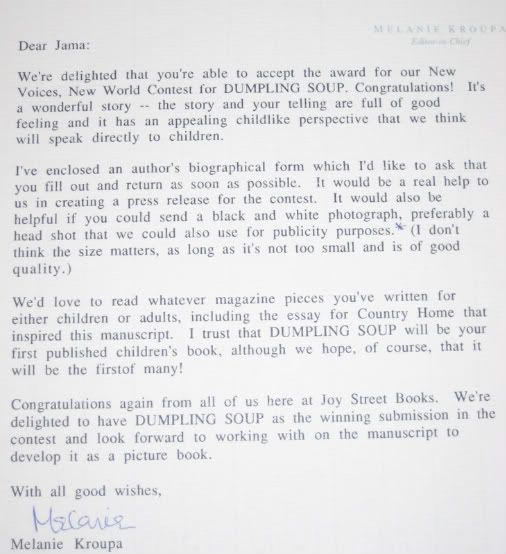
It had taken me five years to revise the book, resubmit, revise, resubmit, again and again. I couldn't have done it without all the suggestions those editors gave me along the way. I didn't belong to a critique group back then; there was no internet, no message boards, no blogs. I cannot emphasize enough how critical it is to get editor feedback. Even a small gesture of kindness or encouragement makes a huge difference to a writer working in isolation. I had written this story in silence, and after I received the news and hung up the phone, I sat there in silence. I simply couldn't believe it.
Once the contract was signed, I revised even more, with the help of three very cool editors: Melanie Kroupa, Ann Rider, and Megan Tingley. Lillian Hsu-Flanders did an awesome job with the illustrations! Loved all her details -- those little dumplings all lined up! those vegetables! those charming facial expressions! She brought my story to life in ways I never could have imagined. There is a warmth in her pictures that still shines through, even though I have seen them a million times. To this day, I remain in awe of artists and illustrators. How do they do it?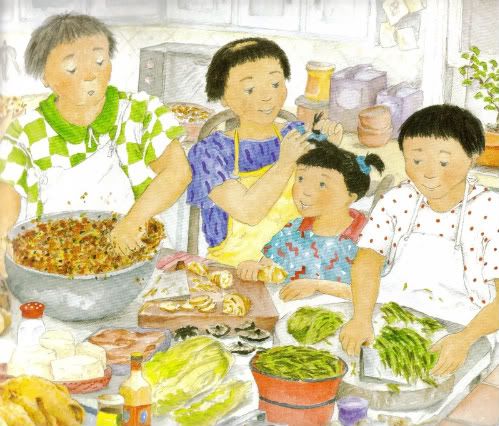
Grandma really did have a big metal mixing bowl.
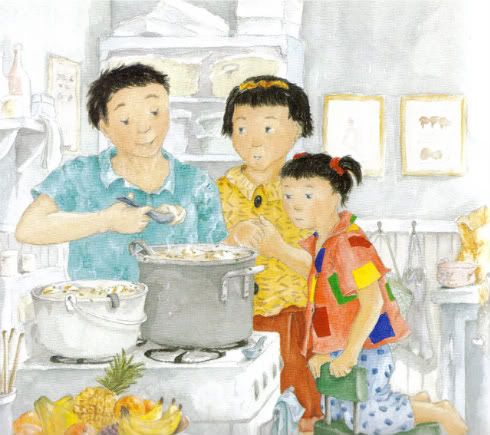
My mother never wore bows in her hair, though :).
This pot of soup has been on the burner a long while, and I will continue to season it with gratitude. Just the other day I received these wonderful photos from my sis, Sylvia, who invites her kids and grandkids to her home in Bend, Oregon, each year for dumpling soup. Their tradition is to read the book aloud and make the dumplings together. For a writer, this is what it's all about!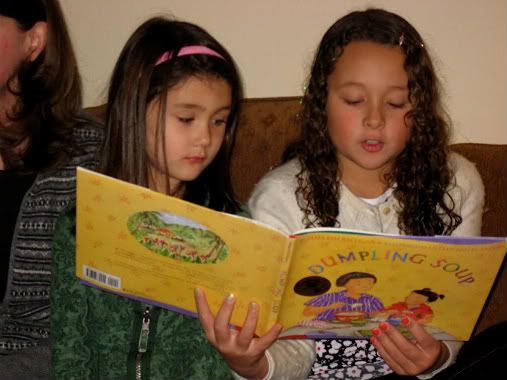
Melia reads, while Marin listens.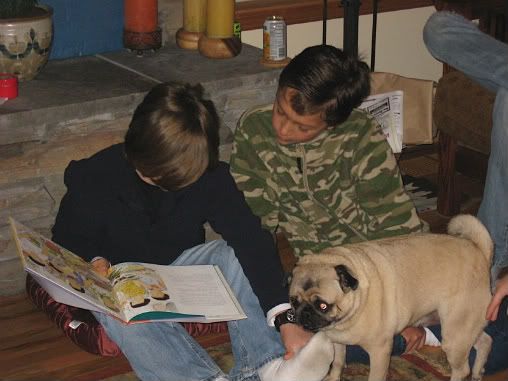
Harri and Keenan get into it (even the dog seems interested)!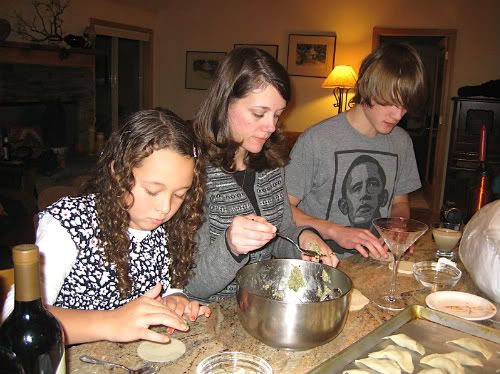
Melia, Kaylin, and Jordi in full work mode (love the Obama t-shirt, Jordi)!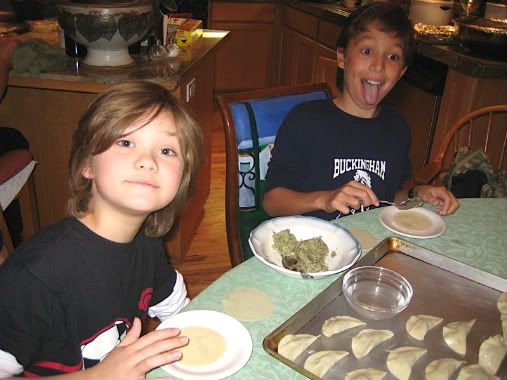
Harri and Keenan are experts by now (good job, guys, )!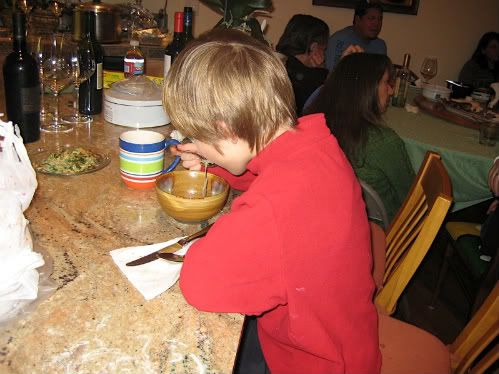
Logan's expertise is chowing down.
But Marin gets the last dumpling!
So, my pretties, if you've read the book, shared it, purchased it, borrowed it, or passed it on -- thank you veddy veddy much! Why not feast on some dumplings, so it will bring you good luck in 2009!!

*All interior spreads copyright © 1993, Lillian Hsu-Flanders, published by Little, Brown. All rights reserved.
Blog: jama rattigan's alphabet soup (Login to Add to MyJacketFlap)
JacketFlap tags: hawaii month, Add a tag
"The moment you doubt whether you can fly, you cease forever to be able to do it. The reason birds can fly and we can't is simply that they have perfect faith, for to have faith is to have wings."
~ from The Little White Bird by J.M. Barrie
"Everything you can imagine is real." ~ Pablo Picasso
"Floating on Air," by Maui artist Beth Marcil, (fine art matted print available here).
Well, hello there, and Happy 2009!
Hope your holiday was delish and delightful, and that the new year brings you laughter, good health, good reading and writing, and a boatload of dark chocolate.
I've had a nice break, punctuated with roast turkey, dover sole with crab and lobster, fresh plum tart, jam cookies, cranberry orange muffins, English breakfast tea, Canadian salmon, crusty sour dough bread, Korean dumpling soup, dim sum, and chocolate truffles. Well, you didn't want me to starve, did you?
I don't do resolutions; I simply recommit myself to the beliefs that have gotten me this far: 1) there is only one joy: to love and be loved, 2) no act of kindness, regardless of how small, is ever wasted, and 3) nothing matters more in this world than how you treat other people. It's about how I want to live.
The quotes by J.M. Barrie and Picasso apply to my writing. Self doubt is my biggest hurdle, but I want to champion the power of my imagination, and the work that is born of it, to help me transcend the pain and struggle. Each of us has the power to create our own reality. I love the painting by Beth Marcil, its Chagallian overtones. Writing is much like free floating -- a little scary, but exhilirating. I hope to untether my earthbound habits and discover new worlds this year.
My motto: BREAK FREE.
So, what's on today's menu?
9 super cool, lovely, seriously faboo things that have me positively panting and googly-eyed with anticipation and excitement: A brand new year of alphabet soup, featuring more SOUP'S ON interviews, reviews and musings on food-related books and other titles too yummy to resist, monthly themes with sprinkles of culinary history, food lore, and recipes, Poetry Friday love, thematic book lists, and, *wait for it* a brand spankin' new ongoing series called "Alphabetica," a neither here-nor-there, serious and silly, you-never-know-what-hit-you or when-it's-coming hodgepodge, i.e., letter porn. There could even be pie!
A brand new year of alphabet soup, featuring more SOUP'S ON interviews, reviews and musings on food-related books and other titles too yummy to resist, monthly themes with sprinkles of culinary history, food lore, and recipes, Poetry Friday love, thematic book lists, and, *wait for it* a brand spankin' new ongoing series called "Alphabetica," a neither here-nor-there, serious and silly, you-never-know-what-hit-you or when-it's-coming hodgepodge, i.e., letter porn. There could even be pie! Congratulations to the 2008 Cybils finalists!! Kudos to all the nominating panelists, Kelly Herold and Anne Boles Levy for all their hard work. I was especially pleased to see Mercy Watson Thinks Like a Pig, by Kate DiCamillo (which I nominated!), and There's a Wolf at the Door, by Zoe Alley, make the cut for Easy Readers and Graphic Novels (Elementary/Middle Grade). (My review of Wolf is here, and my interview with Zoe is here). And I'm looking forward to getting on with my judging duties to help select the Poetry winner!
Congratulations to the 2008 Cybils finalists!! Kudos to all the nominating panelists, Kelly Herold and Anne Boles Levy for all their hard work. I was especially pleased to see Mercy Watson Thinks Like a Pig, by Kate DiCamillo (which I nominated!), and There's a Wolf at the Door, by Zoe Alley, make the cut for Easy Readers and Graphic Novels (Elementary/Middle Grade). (My review of Wolf is here, and my interview with Zoe is here). And I'm looking forward to getting on with my judging duties to help select the Poetry winner! The Presidential Inauguration! I've lived in the D.C. area for 27 years, and have never been this excited! What will it be like to have 4-5 million people flock to The Mall?
The Presidential Inauguration! I've lived in the D.C. area for 27 years, and have never been this excited! What will it be like to have 4-5 million people flock to The Mall? In honor of Barack Obama, the first U.S. President born and raised in my home state of Hawai'i, I will be spotlighting, celebrating, and saluting the 50th state all month long. The tropical menu will feature Hawai'i-related books and authors, music, art, food, and a couple of special guests, including:
In honor of Barack Obama, the first U.S. President born and raised in my home state of Hawai'i, I will be spotlighting, celebrating, and saluting the 50th state all month long. The tropical menu will feature Hawai'i-related books and authors, music, art, food, and a couple of special guests, including: James Rumford, multi-award winning author/illustrator of over a dozen picture books and all-around uber cool Renaissance Man!
James Rumford, multi-award winning author/illustrator of over a dozen picture books and all-around uber cool Renaissance Man! Could there be another Grand Adventure in the cards this year?
Could there be another Grand Adventure in the cards this year? I'm growing a moustache! Nah, just kidding (wanted to see if you're paying attention.) But I could write about moustaches . . .
I'm growing a moustache! Nah, just kidding (wanted to see if you're paying attention.) But I could write about moustaches . . . We'll probably go to Hawai'i this year to visit my family.
We'll probably go to Hawai'i this year to visit my family. I'm having a special giveaway this month, celebrating something special. Check for an announcement tomorrow!
I'm having a special giveaway this month, celebrating something special. Check for an announcement tomorrow!
So, my friends, winter is here, and the cold winds are blowin', but we at alphabet soup are going to try our darndest to warm you up. Think sparkling beaches, warm trade winds, shave ice, flip flops, pupu platters and plate lunches, ukulele, lei, and slack key guitar. And if you must, bikinis, volcanoes, surfboards, palm trees, luaus and hula girls. I'll be happy to meet you on Maui, but please, no Speedos :D !

"The Heavenly Road to Hana," by Maui artist Renee Coates,
(signed, limited edition giclee prints on canvas available here).
"Don't ask what the world needs. Ask what makes you come alive, and go do it. Because what the world needs is people who have come alive."
~ Howard Thurman


